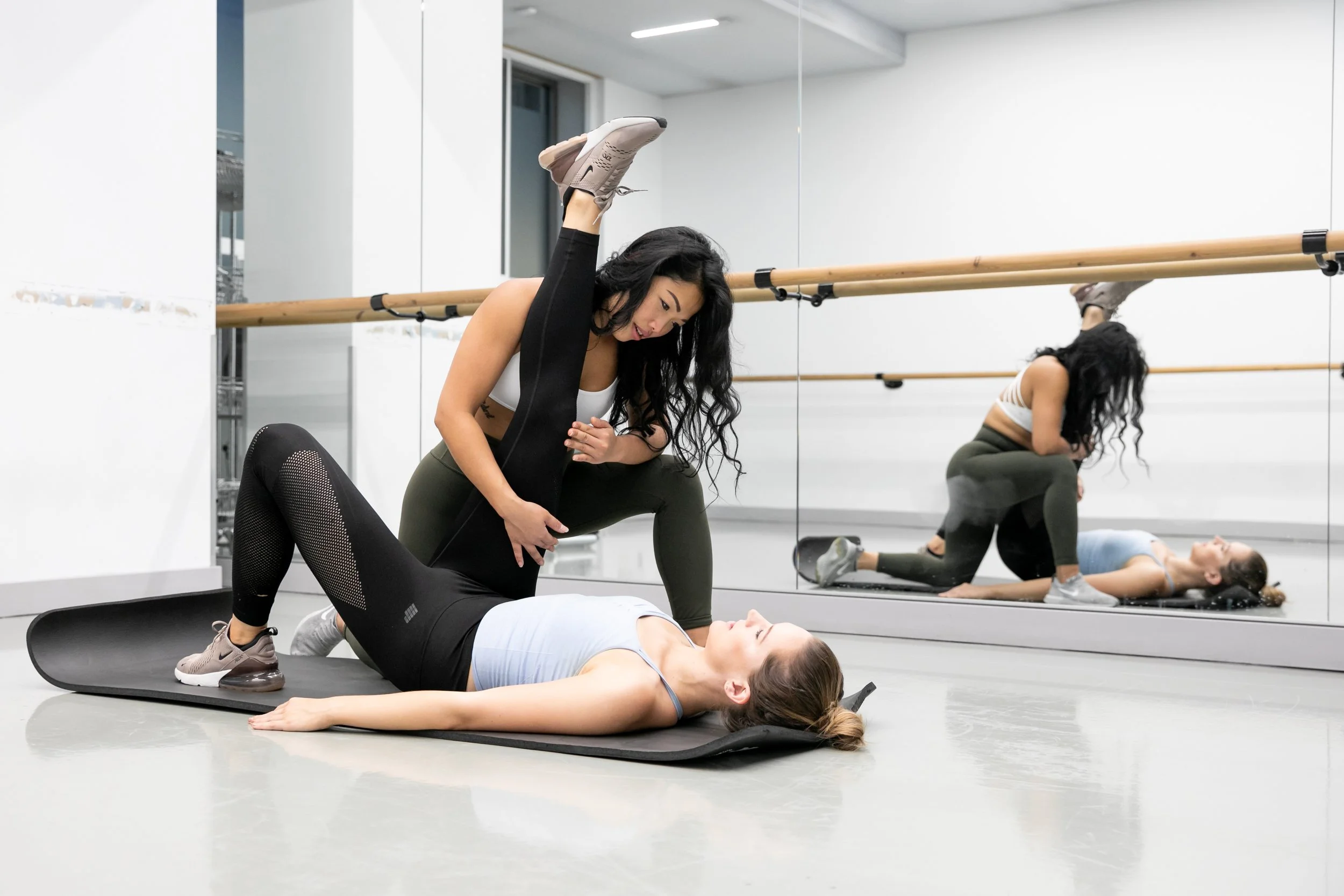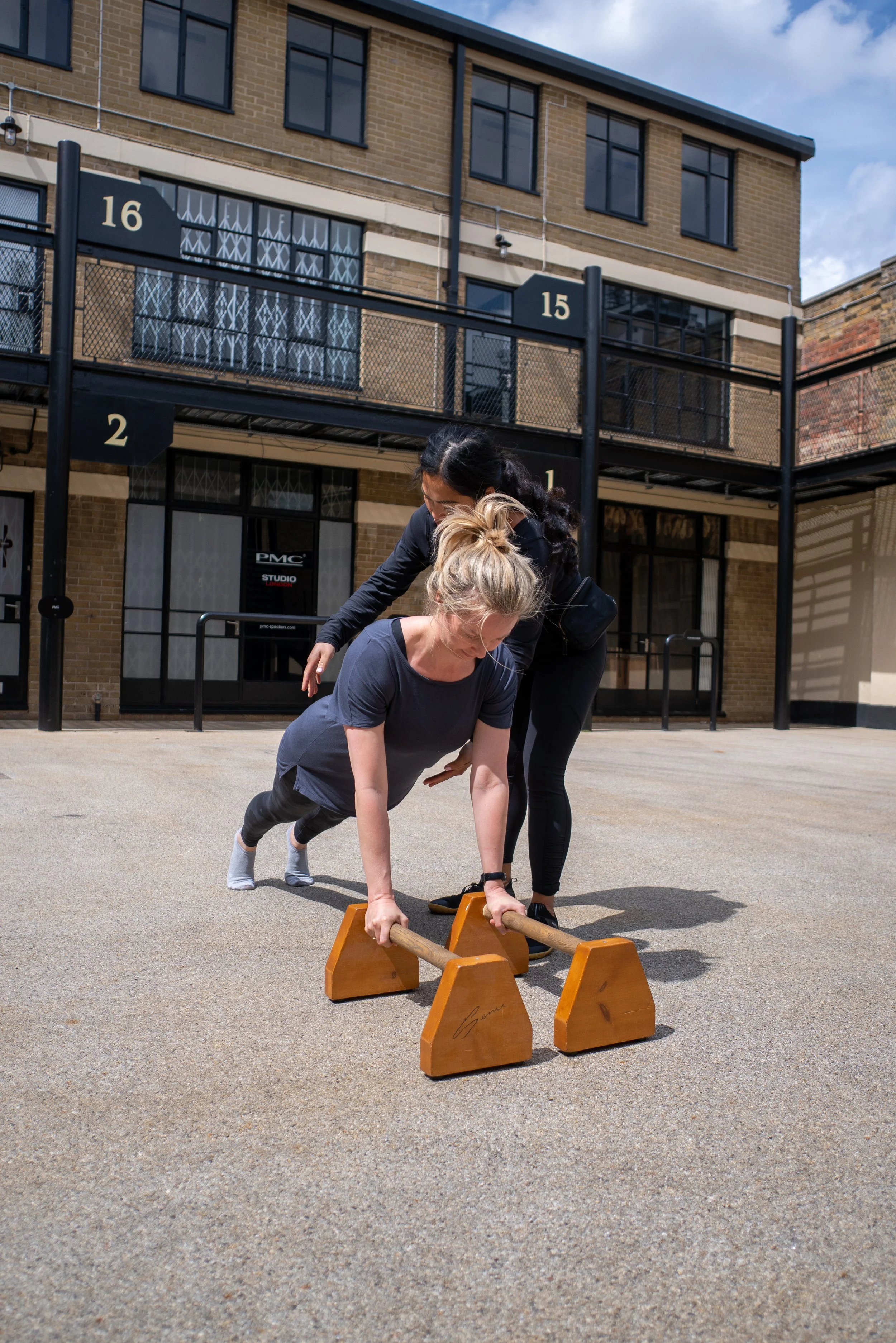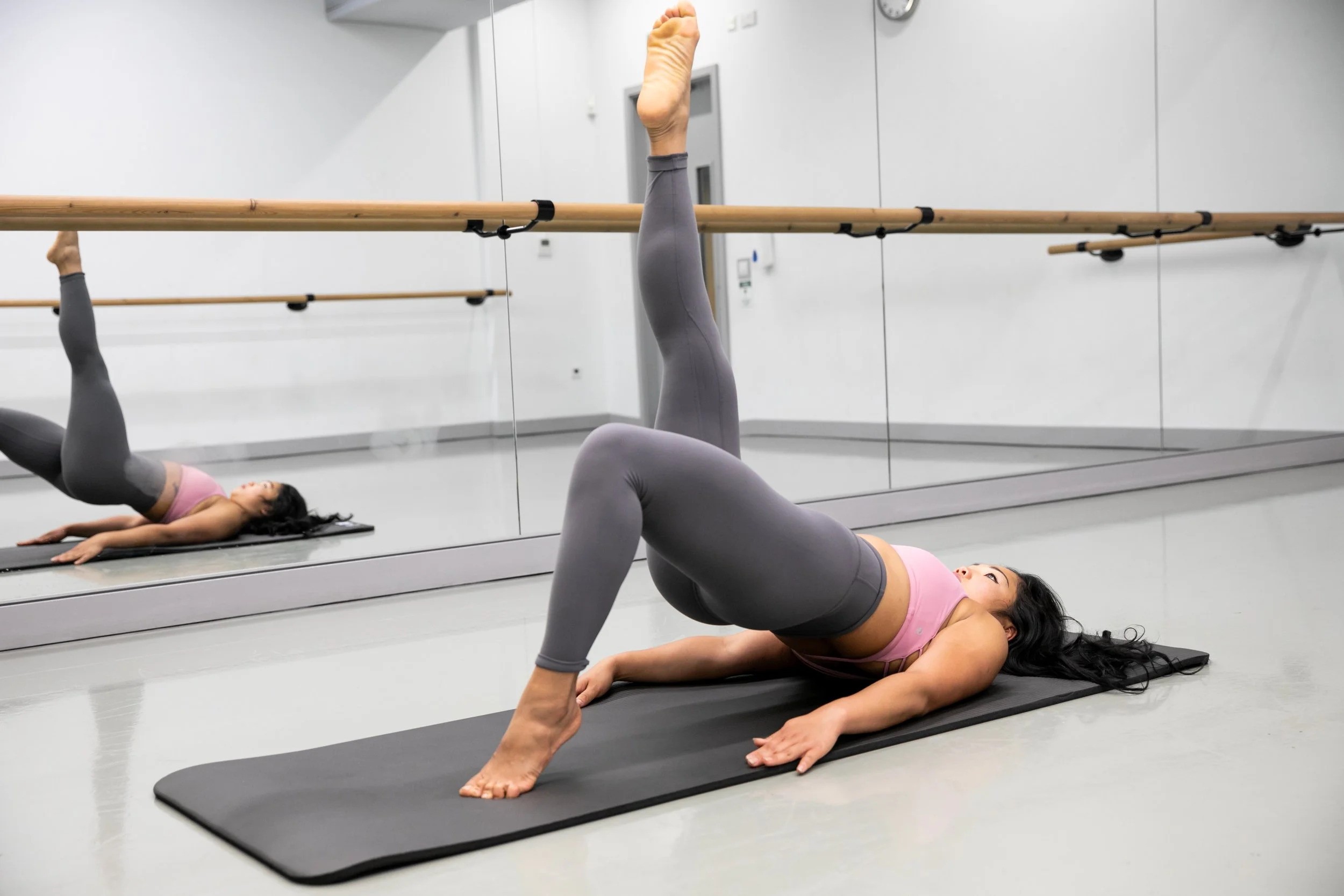
POSTNATAL
Postpartum fitness workouts designed for your birth experience
Postnatal Personal Training: islington
Pregnancy takes a toll on your body. No matter what you see on social media, there are no magical ways that celebrities ‘snap back’ into their pre-pregnancy physique or fitness.
While there are no miraculous quick-fixes, there are proven ways to help you body recover and find new levels of health. At Trang Fitness, our personal trainers understand the science and physiology of pregnancy and post-pregnancy recovery.
As soon as you’re ready, we’re here to help. No public gyms, no queuing for machines, and no feeling of being watched as you workout. Just beautiful studios, friendly and understanding personal trainers, and an exercise programme that works for you.
As is always the case with Trang Fitness, you’re guaranteed a completely bespoke-to-you experience, world-class 1-1 coaching in impeccable private studio space, immaculate changing areas, and no membership fees – ever.
Private Training In Your Own Studio Space
As health and fitness professionals, we’re very aware that typical gym spaces often aren’t appealing to women who are looking to work towards fitness goals. At Trang Fitness, we break the mould – we have private personal training space that are exclusively yours when you work with your qualified personal trainer.
Everything you need for your tailored workouts can be found in your pod – including cardio and strength training equipment, as well as all those other useful items that can be hard to track down in a gym – like mats, rollers, steps, balls, and more. What’s more, the only eyes on you will be your dedicated coach – because privacy is important for everyone.
We'll Help You Feel 'You' Again
Giving birth is usually one of the most physically traumatic things that happens to a person’s body. For nine months, your body has been transformed into an incubator for the baby growing inside you – then, giving birth puts an untold strain on virtually every muscle you have.
As such, it’s perfectly normal to feel different after giving birth. Your body will almost always feel different – and the sudden changes in hormones and bodily processes can leave your brain feeling different too.
At Trang Fitness, we do more than ‘just’ personal training. We’ll help you understand what your body has been through, then help you make adjustments to ensure your recovery is as smooth as possible. Managable and safe exercise is at the heart of what we do – but we’re also qualified to talk to you about how your diet, levels of rest, and other lifestyle factors will help recovery too.
The Advantages of Exercise After Childbirth
Start From A Strong Foundation
-
Parenting can be highly taxing on the body. Training your body can help reduce your chances of pain and give your body more support.
Not to be all does-what-it-says-on-the-tin about it, but exercise will literally increase the amount of strength your muscles and bones have and what they're able to endure. This can help with post natal recovery and, life with a newborn.
-
Postnatal strength training is beneficial to all women, it not only helps to restore physical health, but can also help to improve low mood, sleep quality, relieve stress and help to prevent postnatal depression.
I found that being fit and healthy also improves stamina levels, helping mothers to cope with the demands of motherhood. Joining in with regular exercise is also a social activity, meeting with other women going through a similar experience can provide additional support and boost morale making mothers feel more positive about the birth of the baby.
-
As your baby grows, your center of gravity shifts, which can affect your posture and balance. Exercise focus on core strength and stability can help you maintain proper posture and reduce the risk of falls or injuries.
-
During pregnancy the body experiences a hormonal transformation. Following birth, hormone levels begin to return to their normal level and for some women this can lead to mood swings, feelings of anxiety, irritability and tearfulness.
Some women develop postnatal depression which is characterised by continuous low mood and irritability, negative thoughts, low energy, poor sleep and in some cases, difficulties caring for the baby. Exercising is mood enhancing, can help to promote a natural hormonal balance.
-
Exercise focusses on building effective core strength and improving the function of the pelvic floor, reducing your risk of incontinence and prolapse.
Improve mind & body confidence
-
Understand these issues, and how to train safely and effectively with them, without fear.
-
During pregnancy and childbirth all women experience a massive physical transformation of their bodies – throughout pregnancy internal organs, soft tissue structures and skin are all forced to stretch to accommodate the baby. Following birth, it takes some time for the body to recover and for everything to reduce back to its original size.
How quickly this process takes place can depend on many things, including fitness level prior to pregnancy, diet, postnatal exercise and genetics – every woman is different, and individuals may take varying amounts of time to regain their former shape following birth. There is however, no doubt as to the importance of postnatal exercise.
-
Keeping optimal musculoskeletal and cardiovascular strength is proven to have far reaching health benefits during pregnancy.
-
A gradual increase in impact and cardiovascular exercise will help you get back to the exercise you really love, safely.
Exercise offers various health benefits, such as improved cardiovascular fitness, enhanced bone density, and better coordination. These advantages can be especially valuable during postpartum.
-
Training is something that can set you and your body up for life – not just postpartum. And, one way it can really support you is post-pregnancy when a small weighted object will need you and your lifting abilities on the reg.
Exercise in postpartum will pay huge dividends when it comes to life after your baby , helping you look after your newborn with all of the lifting, carrying and pram pushing.
What to expect during your post-natal exercise training session?
-
Here are some key components that may be included in our exercise session
-
The session usually begins with a warm-up to increase blood flow, warm up the muscles, and prepare the body for exercise. This may involve light cardiovascular activities, dynamic stretching, or mobility exercises.
-
The session will incorporate exercises that target major muscle groups throughout the body, such as squats, lunges, push-ups, rows, and shoulder presses. These exercises help to rebuild overall strength, improve functional movement, and enhance overall body tone.
-
Postnatal strength training often prioritises core muscle activation and reconnection. This may include exercises such as pelvic floor exercises, gentle abdominal work, and exercises that target the deep core muscles to help restore core stability and support.
-
The use of resistance bands, dumbbells, kettlebells, or bodyweight exercises may be incorporated to provide resistance and further challenge the muscles. The intensity and weight used will depend on individual abilities and goals.
-
Postnatal strength training often emphasises exercises that improve posture and alignment, as pregnancy and childbirth can impact posture. These exercises may include exercises for the back, shoulders, and hips to counterbalance any postural changes that may have occurred during pregnancy.
-
Stretching exercises or gentle yoga-inspired movements may be included at the end of the session to improve flexibility, release tension, and promote relaxation.
How you can join us?
One to One
Personal Training
four to one - Lifting Ladies
Postpartum Training Tips
-
It's crucial to consult with your healthcare provider and listen to your body as you embark on your strength training sessions. Take it one step at a time and celebrate the progress you make along the way.
-
Download the Squeezy App. Focus on rebuilding core strength and addressing any pelvic floor issues that may have occurred during pregnancy and childbirth.
Include exercises such as pelvic floor contractions, deep abdominal engagement, and gentle core movements to restore stability and support.
National NICE – national institute for health and care excellence– guidelines recommend all pregnant women do daily pelvic floor squeezes,'
And having a strong pelvic floor, stretches into fitness too, helping safely strength train for longer and heavier without increasing their risk of pelvic floor problems.
'When lifting any weight, our core cylinder automatically has to engage,' . The pelvic floor is situated at the bottom of – and is the most important part of – our core. A strong one means a strong core which means you'll be able to lift heavier weights more safely.
How to do pelvic floor squeezes
Simply, you need to pretend you're stopping wind – you should feel a tightening and lifting sensation that begins at the back passage, adding that there should be no external signs from the outside that you're doing them. The rest of your body – stomach, legs and bum should all stay still.
How many pelvic floor squeezes to do
'Eight squeezes at least three times a day. But, ideally, these need to be short and long ones.
Short squeezes are where you squeeze and release immediately.
Long squeezes are where you squeeze and hold for 10-seconds before letting go.
If you feel like you're not fully releasing between each one – which, heads up, you need to do – take a deep breath in and out. That should release the tension.
-
Begin your postnatal strength training with bodyweight exercises that allow you to focus on proper form and technique. Movements like squats, lunges, push-ups, planks, and bridges can be effective in rebuilding strength without the need for additional equipment.
-
As you regain strength and confidence, gradually progress by adding resistance to your workouts. Start with lighter weights or resistance bands and increase the load gradually over time.
-
Include exercises that mimic daily activities and movements to improve functional strength. This can help you regain strength and stability for everyday tasks such as lifting, carrying, and bending.
-
Be mindful of how your body feels during and after each exercise. If you experience pain, discomfort, or any unusual symptoms, modify or stop the exercise. It's important to respect your body's signals and progress at a pace that feels comfortable for you.
-
Allow for adequate rest and recovery between strength training sessions. Your body needs time to repair and rebuild muscle tissue. Aim for at least 48 hours of rest between sessions or alternate strength training days with cardio or flexibility-focused workouts.
-
Drink plenty of water before, during, and after your workouts to stay hydrated. Additionally, nourish your body with a balanced diet that includes sufficient protein, complex carbohydrates, and healthy fats to support muscle recovery and overall postnatal wellness.
-
Pay attention to your energy levels and adjust the intensity or duration of your workouts accordingly. Rest when needed and avoid pushing yourself beyond your current capabilities. It's important to prioritise self-care and support your overall well-being during the postnatal period.
Postpartum Exercise FAQs
-
After a natural birth, your GP should sign you off for exercise after your 6 week check up. After a c-section, you should wait at least 12 weeks before training. Of course, it goes without saying there’s absolutely no rush to start a fitness programme.
There are small exercises you can start doing before you are signed off for training in the gym – breathing work, pelvic floor exercises and core activation being especially important. Your personal trainer will guide you with these exercises and explain how to gradually build up.
Check out our blog on: exercising after a C section.
-
You are never too late to join us! Our workout has been designed tailor for everyone, no matter where they are in their postnatal journey. We split our post natal plan into phases based on where you are in your recovery, and you can move through the phases at your own pace.
check out: The importance of postnatal training
-
As soon as you feel you are ready, we can begin to focus on the pelvic floor muscles. This is important because it will help prevent incontinence, which leads to leaking urine.
Specifically designed for postnatal women, our online and in-person programs incorporate a blend of resistance, stability, and postural exercises proven to help burn unwanted body fat, improve strength, boost metabolism, strengthen the lower back and tone the muscles in the stomach, bum, chest, thighs and arms.
Typically, it takes up to four months for your pelvic muscles to recover. Once you feel they have recovered we can resume more heavy resistance and abs workout exercises such as sit-ups and ab-crunches. Other activities may include resistance training, Pilates, medicine ball and swiss ball work, low-impact circuits and full core conditioning.
check out our blog on: postnatal pilates
-
Post-natal strength training is by far one of the most effective ways to regain your previous figure, and even improve on it. However, this change won’t necessarily happen quickly.
We will set realistic goals for you, and increase your strength training gradually. It is important not to overload yourself with pressure. Nine months of carrying a baby is hard work!
check out our blog on: 15 tips to lose fat safely & sustainably
-
Within just a few weeks of sessions with one of our personal trainers you will have more energy, greater stamina, less stress, greater flexibility, increased self-esteem and far greater body confidence.
By combining specific techniques with correct eating habits, our postnatal personal trainers can help you to lose your baby weight, increase your energy and tone your body enabling you to better cope with the demands of motherhood.
find out the benefits of postnatal training in this blog
-
All of our professional personal trainers hold nationally accredited postnatal fitness certifications and have many years of experience working with new mums.
Most of our trainers also hold advanced academic degrees in health sciences, fitness and physical therapy. This means that our personal trainers are able to get you the real results you want whilst ensuring you adopt safe and proper technique at all times.
Diastasis FAQs
-
Diastasis Recti is an excessive widening and thinning of the linea alba, or the tissue on the right and left side of the abdominals. Diastasis recti is a prevalent issue among postpartum women.
-
Postnatal exercise is not only safe for most women with this abdominal separation, but it can actually help to support regeneration of the abdominal tissue.
Pilates mix exercise is also beneficial for any pelvic floor issues that might have occurred during pregnancy or labor and delivery (such as tearing), which can cause shooting pain, pain during sex and problems with bladder function such as urinary incontinence.
-
If you have diastasis recti, stay away from forward flexion (exercises like crunches), since these place too much load on the abdominals and pelvic floor and can potentially exacerbate the issue. The last thing you want to do is to make that separation worse.
-
Gentle Core Exercises
Engage in exercises specifically targeting the deep core muscles, such as transverse abdominal exercises and pelvic floor exercises. Avoid exercises that put direct stress on the abdominal muscles, like traditional sit-ups or crunches.
Posture Awareness
Maintain proper posture throughout the day, as slouching can worsen diastasis recti. Focus on sitting and standing tall with your shoulders back and your spine aligned.
Supportive Belly Binders or Splints
Consider using a belly binder or splint specifically designed for diastasis recti to provide support to the abdominal muscles and aid in their healing process.
Avoid Heavy Lifting
Steer clear of heavy lifting or straining activities that can put pressure on the weakened abdominal muscles and potentially worsen the condition.
Gradual Return to Exercise
If you're cleared by your healthcare provider, gradually reintroduce exercise into your routine, starting with low-impact activities like walking, swimming, or prenatal yoga. Listen to your body and progress at a pace that feels comfortable.
Breathing Techniques
Practice diaphragmatic breathing to engage the deep core muscles and promote overall abdominal strength and stability.
Nutrition and Hydration
Maintain a balanced diet that includes sufficient protein, vitamins, and minerals to support the healing process. Stay hydrated to aid in tissue repair and overall well-being.
Patience and Consistency
Diastasis recti recovery takes time, so be patient with your body and give it the time it needs to heal. Consistency in performing targeted exercises and following recovery guidelines is key.
Remember, it's crucial to consult with a healthcare professional or a specialist in postpartum fitness to receive personalized guidance and ensure safe and effective diastasis recti recovery.





